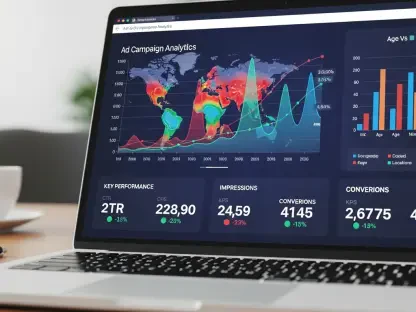In the fast-paced world of digital advertising, where every click and impression can determine the success of a campaign, programmatic platforms have emerged as indispensable tools for advertisers and publishers alike. Imagine a scenario where a retail brand aims to capture holiday shoppers with precision targeting, while a news website struggles to monetize its vast inventory without compromising user experience. This dichotomy underscores a critical divide in the ad-tech ecosystem: the distinct yet interconnected roles of Demand-Side Platforms (DSPs) and Supply-Side Platforms (SSPs). These technologies power the automated buying and selling of ad space, shaping how billions of dollars are spent and earned in real time. This analysis dives deep into their functionalities, differences, and challenges to illuminate how each serves unique stakeholders in the digital marketing landscape.
Understanding DSP and SSP Platforms: Foundations and Roles
At the heart of programmatic advertising lies a sophisticated ecosystem where DSPs and SSPs play pivotal roles in facilitating transactions between advertisers and publishers. DSPs are tools designed for advertisers, enabling them to purchase ad inventory through real-time bidding (RTB) across various channels like display, video, and connected TV (CTV). They harness data-driven targeting to optimize campaigns, ensuring ads reach the right audience at the right time. On the other hand, SSPs cater to publishers by streamlining the sale of ad space, managing auctions, and optimizing inventory to maximize revenue. Together, these platforms form the backbone of automated ad trading, bridging the gap between those who create demand and those who supply inventory.
The significance of DSPs and SSPs in digital marketing cannot be overstated, as they address the specific needs of their respective users while intersecting in shared ad exchanges. For advertisers, DSPs offer a gateway to efficiency, allowing campaign adjustments based on performance metrics like conversions or click-through rates. Conversely, SSPs empower publishers to focus on monetization strategies, ensuring high fill rates and competitive pricing for their ad slots. Despite their different focuses, both platforms rely on real-time data and algorithmic precision to function within the same marketplace, often interacting through intermediaries like data management platforms (DMPs).
This complementary dynamic sets the stage for a nuanced comparison, as DSPs and SSPs, while distinct in purpose, collectively drive the programmatic engine. Their interplay ensures a balance of interests—advertisers gain access to premium inventory, while publishers secure optimal earnings. Understanding their individual contributions and overlapping functionalities provides a foundation for evaluating which platform better suits specific business goals in the ever-evolving ad-tech space.
Key Differences in Functionality and Performance
Target Audience and Core Objectives
DSPs and SSPs serve fundamentally different audiences with contrasting primary objectives within the programmatic advertising framework. DSPs are tailored for advertisers and agencies aiming to deliver targeted campaigns to specific demographics, prioritizing outcomes like audience engagement and return on ad spend. Their goal is to place ads where they will generate the most impact, often focusing on metrics such as impressions leading to purchases. In contrast, SSPs are built for publishers who seek to monetize their digital real estate, emphasizing revenue per impression and ensuring ad spaces are filled with high-value bids.
These differing priorities manifest in distinct operational focuses that shape their day-to-day utility. A DSP might be leveraged by a retail brand to optimize a holiday campaign, fine-tuning bids to target users based on browsing history or location data for maximum conversions. Meanwhile, an SSP could be employed by a news website to manage ad inventory during high-traffic events, adjusting price floors to attract premium advertisers and boost earnings. This split in intent—performance for DSPs versus yield for SSPs—highlights their specialized roles in catering to opposite ends of the advertising spectrum.
Technology and Features
The technological underpinnings of DSPs and SSPs reveal tailored feature sets designed to meet their unique user needs. DSPs often incorporate advanced targeting capabilities, such as geofencing for location-based ads and CRM integration for personalized messaging, alongside creative optimization tools to test ad formats in real time. Many also utilize artificial intelligence to adjust bids dynamically, ensuring cost efficiency while maximizing campaign reach across multiple formats like video or native ads. These features collectively aim to refine how advertisers connect with audiences.
SSPs, by comparison, focus on inventory management and auction efficiency, offering tools like header bidding to increase competition among buyers and price floor settings to safeguard revenue. Their algorithms prioritize matching ad space with the highest-paying demand, often integrating analytics to predict inventory value. Platforms like SmartyAds, which provide both DSP and SSP functionalities, showcase how these technologies can overlap—offering targeting precision on one side and yield optimization on the other—yet maintain distinct cores geared toward buying or selling efficiency.
The divergence in technological focus underscores how DSPs and SSPs address specific pain points in the ad-tech chain. While DSPs empower advertisers with granular control over campaign execution, SSPs equip publishers with mechanisms to protect and enhance the value of their digital assets. This split in feature design ensures each platform excels in its domain, though it also means users must align their choice with specific technical requirements.
Integration and Ecosystem Impact
Within the broader ad-tech ecosystem, DSPs and SSPs interact with shared components like DMPs, ad exchanges, and third-party tools, but their roles in these integrations differ significantly. DSPs act as gateways for advertisers to access diverse inventory across channels, from display to digital out-of-home (DOOH), enabling omnichannel strategies that unify brand messaging. Their connectivity often extends to multiple exchanges, ensuring broad reach, though this can come with challenges like hidden fees or fragmented reporting.
SSPs, conversely, streamline the supply chain by connecting publishers to various buyers through centralized platforms, focusing on inventory control and transparency. They enable publishers to dictate terms of sale, such as preferred ad formats or buyer restrictions, while integrating with DMPs to enhance inventory appeal through data enrichment. However, complexities in onboarding or managing low-quality traffic can hinder their seamless operation within the ecosystem.
The impact of these platforms on the advertising landscape reveals both strengths and limitations. DSPs offer advertisers the advantage of expansive reach and campaign flexibility, while SSPs provide publishers with autonomy over monetization strategies. Yet, challenges like latency in real-time bidding affect both, and their interdependence in ad exchanges means inefficiencies on one side can ripple across the system, necessitating careful selection based on ecosystem compatibility.
Challenges and Limitations in Implementation
Navigating the adoption of DSPs often involves grappling with obstacles that can impede campaign success. Limited transparency in bidding processes can obscure true costs, leaving advertisers uncertain about where their budget is allocated. High initial setup costs and a steep learning curve for optimizing campaigns further complicate usage, especially for smaller businesses with constrained resources. These hurdles can delay the realization of a DSP’s full potential, requiring significant investment in time and expertise.
SSPs present their own set of implementation challenges, particularly for publishers aiming to balance revenue with user experience. Managing low-quality ad traffic remains a persistent issue, as irrelevant or intrusive ads can alienate audiences. Additionally, adapting to privacy regulations in a cookieless environment poses technical difficulties, while the pressure to maintain high fill rates can sometimes compromise ad placement quality. Such factors demand constant vigilance and adaptation from SSP users.
Ethical and technical concerns further cloud the landscape for both platforms, impacting their broader adoption. DSPs risk criticism for overly intrusive targeting practices that may infringe on user privacy, while SSPs face vulnerabilities to ad fraud, where malicious actors exploit inventory for illicit gains. Latency issues in real-time bidding also plague both systems, potentially disrupting ad delivery. These shared and unique challenges highlight the need for ongoing improvements in transparency, security, and user-friendliness to ensure trust and efficiency in programmatic advertising.
Choosing the Right Platform: Summary and Recommendations
DSPs and SSPs stand as pillars of programmatic advertising, each excelling in distinct areas that cater to specific industry players. DSPs shine in delivering precision targeting and multi-channel campaign execution, making them ideal for advertisers focused on performance metrics and audience reach. SSPs, by contrast, dominate in inventory management and revenue optimization, serving publishers who prioritize earnings and control over ad space. Their strengths reflect tailored solutions for buying versus selling in the digital ad marketplace.
Key comparison points underscore these differences, with DSPs offering robust tools for campaign customization and real-time adjustments, often integrating AI for enhanced decision-making. SSPs counter with auction management features like header bidding and price floor optimization, ensuring publishers maximize yield. While DSPs facilitate omnichannel strategies, SSPs empower publishers to navigate complex supply dynamics, though both face hurdles like transparency issues or regulatory shifts that require careful consideration during selection.
For businesses deciding between these platforms, alignment with core needs is paramount—advertisers seeking impactful campaigns might opt for a DSP like StackAdapt for its traffic-boosting capabilities, while publishers aiming for streamlined monetization could turn to an SSP like Publift’s Fuse for operational ease. For those with dual interests, hybrid solutions such as SmartyAds or OpenX offer a blend of DSP and SSP functionalities, fostering a cohesive advertising strategy. Ultimately, the choice hinges on specific goals, resources, and the capacity to address inherent platform challenges.
Looking back, the exploration of DSPs and SSPs revealed critical insights into their transformative impact on digital advertising. As businesses reflect on their strategies, the path forward becomes clearer: evaluating integration needs and scalability emerges as a vital next step. Publishers and advertisers alike should consider investing in training to overcome learning curves, while exploring partnerships with hybrid platforms offers a promising avenue to bridge operational gaps. Embracing evolving privacy standards also stands out as a priority, ensuring long-term adaptability in a dynamic landscape where technology and user expectations continually shift.









